X-Fi and the Elite Pro: SoundBlaster's Return to Greatness
by Derek Wilson on August 30, 2005 11:59 AM EST- Posted in
- Smartphones
- Mobile
Performance and Quality: Game Tests
For these tests, we will be looking at RightMark 3DSound 2.0 and Battlefield 2. With the possibility of twice the number of voices supported by Audigy, we can't do a direct comparison at some points. However, we will see how much impact going from 62 to 127 voices can have.Our test system included these components:
NVIDIA nForce 4 based motherboard
AMD Athlon 64 FX-55
1GB DDR400 2:2:2:8 RAM
NVIDIA GeForce 7800 GTX
120GB Seagate 7200.7 HD
Our RightMark tests show that the Audigy 4 Pro uses less CPU power per setting than the X-Fi. This was a little confusing at first, but we have our thoughts on why this happens. It seems to make sense to us that the X-Fi driver is more complicated than the Audigy driver. We therefore see slightly lower performance from the X-Fi card. With the X-Fi being brand new, driver improvements could also change the performance picture over time.
This performance issue should be different on the higher end X-Fi cards with games that support X-RAM. Unfortunately, we can't test this yet as no games we looked at have this ability. Storing uncompressed audio and not needing to run an MP3 or Ogg decoder in the background would help to significantly lighten the CPU load on most games. Note also how CPU usage increases nearly linearly with the number of voices used.
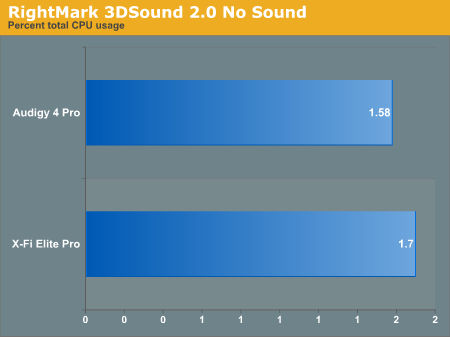
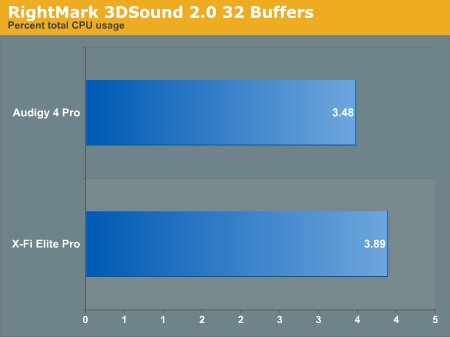
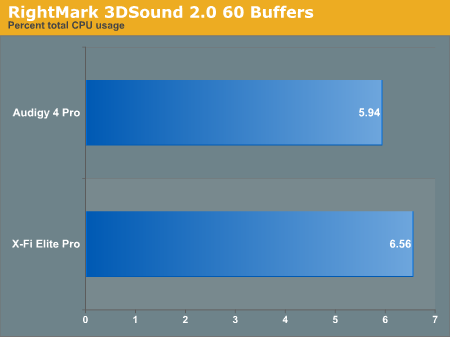
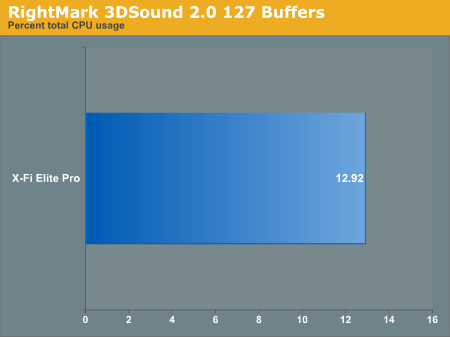
For Battlefield 2, we ran our usual test at medium quality settings at 1024x768. The Ultra High quality option in Battlefield 2 is only accessible with an X-Fi card (which likely means it employs more than 62 voices). As we can see, BF2 performance is consistent with our RightMark numbers. The X-Fi gives us just a little lower performance than the Audigy. It is nice to see that going from High Quality to Ultra High Quality on the X-Fi doesn't incur a significant performance penalty though.
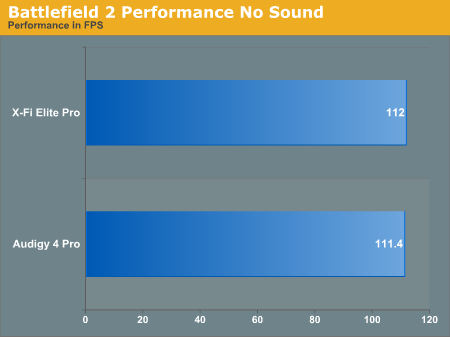
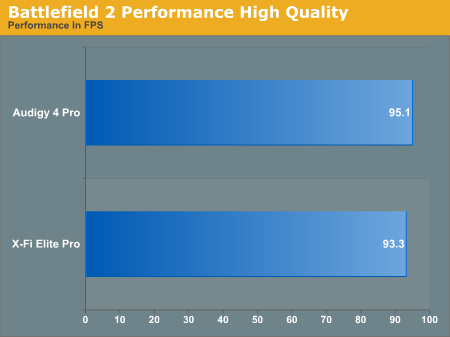
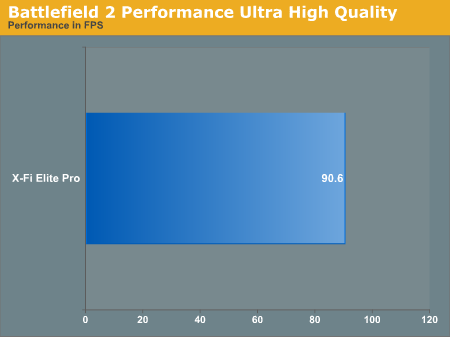










110 Comments
View All Comments
yacoub - Wednesday, August 31, 2005 - link
As does "it's just bloatware and marketing".Eskimooo - Wednesday, August 31, 2005 - link
PCIe is designed for graphics and high data transfer, but audio sends very small packets and the overhead can be big. Performance of PCIe is bad for audio, therefore no-one was tempted to come up with a product yet...Correct me if I am wrong.Creative says they are working on that, I have just came across this interview:
http://www.hardwarezone.com/articles/view.php?cid=...">http://www.hardwarezone.com/articles/view.php?cid=...
Araemo - Wednesday, August 31, 2005 - link
From that interview:"So what we have to do is go back to the drawing board and work on the transport part of the chip and re-design it to add more silicon to overcome some of the problems we had with PCIe. So for us to come up with a PCIe solution is going to take a while because we have to overcome the problems we're facing with that bus."
It sounds like they thought it would be a simple transition, and had their product mostly designed(around PCI 2.x) before they tried to adapt it to PCI-Express.
In order for sound cards to make efficient use of an overcrowded PCI bus(common in older chipsets, before the nforce era or so), they had to pull a LOT of tricks, including using a very low(relatively speaking) IRQ. W/ the PCI-express bus, they have to re-engineer their chips to send data earlier, since it is sent serially instead of parallel, meaning they can't buffer one big clump and expect it to get to the destination all at once, they have to send the first part when it's ready, and then the second part.. sequentially.. I just honestly thought that the delay in the X-Fi WAS to get pci-express working.. It's not like they haven't had plenty of time (What, 3? 4? years since the first working silicon was available for engineers to test on?)
I think if creative had a serious competitor, they may have been more eager to have pci-express support, but since noone else is even making a dent in their market, they only need to improve over their past product... and that isn't hard to do.
Spacecomber - Wednesday, August 31, 2005 - link
I was a little surprised to see that the X-Fi has a higher level of CPU usage and results in a sligthly lower FPS average when playing Battlefield 2 than what you can get with an Audigy card. I really would have hoped that all that onboard processing power would have taken a significant load off of the CPU, but perhaps this will improve with newer drivers down the road, as you seemed to suggest.I wondered if this might not deserve a bit of a closer look. An average of FPS, as you know, doesn't really do a very good job of capturing how well a game runs on particular system. This seems especially to be true with Battlefield 2. For example, when I run a timedemo of this game and then exam the cvs file, which captures the time for each frame rendered, I see that while my system gets an average of 50 fps, the range is from 2-106 fps. If you look at a graph of all these framerates, it looks prety ugly with all those momentary dips into single digits and low teens.
My wishful thinking is that a sound card that is capable of taking more of the load off of the CPU might help with this. Even if the average frame rate was slightly lower, if it cleaned up some of those framerate dips, it would still be a good thing.
By the way, how did you disable sound in Battlefield 2 for you tests? Did you simply lower all the sound settings to 0, or is there a command line switch or console command that will do this? I've been meaning to run a timedemo with no sound to compare to a timedemo with sound just to see if the audio contributes significantly to the framerate dips mentioned previously.
Thanks for this review. As an avid gamer, despite my frustration with Creative's cards, they still seem to be the undisputed gamer's card, simply because no one else fully supports all the 3D effects (such as the latest EAX features) in hardware that Creative does. And certainly, no other game card manufacturer is in the position (that Aureal was at one point) to challenge Creative with a competing set of 3D audio effects and features. Much as I'd like to jump to someone else's solution (I loved my Aureal card while it was supported, and I also was happy with my Santa Cruz when Turtle Beach kept their drivers up to date), I'm skeptical that any one really has the clout, now, to establish themselves as a solid card for game players or that they could survive under Creative's shadow.
Spacecomber
jr9k - Wednesday, August 31, 2005 - link
[quote]We therefore see slightly lower performance from the X-Fi card. With the X-Fi being brand new, driver improvements could also change the performance picture over time. [\quote]Given creative's past record, don't count on them.
Seems a nice card though, once it is available at 50$
ceefka - Wednesday, August 31, 2005 - link
So if you do run a comprehensive audio test, please also differentiate between Intel and AMD machines and subsequently Intel, nF3 and nF4 chipsets. Also vary on graphics cards. It is said that a higher grade PCI-E graphicscard on nF4 increases latency. Maybe you can shed your own light on that. Please use excessive amounts of audio and processing and push the systems real hard.While the X-Fi looks to have some nice tech to it, I am afraid that a lot of its tech will sit unused for years to come while missing a few attractive things like Dolby Digital Live and balanced inputs.
Eskimooo - Wednesday, August 31, 2005 - link
I have read DDL may introduce delays like the DICE did with first XBOX. This whole DDL does not mean cinema quality and does not make a card. DDL is not as goog as full dolby. And it always means compression. So it is just a feature which I can live without. I have good analog set anyway. Balanced inputs are important for those who need them. I presume EMU will come up with something but I do not think I want to wait. X-Fi is the best option for me, thanks for all your comments that helped me a lot. Does anybody know where I can order it in Europe?stmok - Wednesday, August 31, 2005 - link
I've been using dual CPU (and now dual-core) systems for quite a while, and Creative have dissappointed me time and again with their Windows drivers...Constant "pops and clicks" is always present with the Live and Audigy series. However, this doesn't occur in Linux...For some reason its fine. (I guess its a different driver team working on it).So my question is, does this new Creative solution suffer from the same issues as its older ones? (Where you are forced to either try third-party drivers OR disable Hardware Acceleration just to get rid of the "pops and clicks" in games/videos/music)
The Blue Moose - Tuesday, August 30, 2005 - link
Let's assume you actually need a semi-pro sound card. Is Creative really going to be your first choice? At the $400-$500 price point you have a few options. Given Creative's less than stellar track record with drivers and software support, only those who insist on the absolute cleanest sound above all else will jump right into this one. This will be those who can (or at least think they can) hear the difference between Audigy sound and X-Fi sound.So, now let's look at the more mainstream version. $130 for a card that uses lesser components (therefore will show even less difference from current Audigy cards), won't have the on board RAM, and doesn't do Dolby encoding. I can get the same sound quality, WITH Dolby encoding for $100 or less right now. Plus the same driver/support issues apply here as well.
Now, most hardcore gamers aren't gonna pop for a semi-pro card they don't need, nor will they skimp by grabbing the low-end board. I'm assuming the $280 version will have middle of the road components, but it will definitely have the RAM. They won't buy it for cleaner sound necessarily, but more for the potential performance boost of the RAM.
But, how much of a boost will there be? The (admittedly limited) benchmarks would seem to show there's a good bit of driver overhead. Also, with dual core chips filtering down to the masses, will the RAM actually get you that much more? Many game designers have said how very hard it will be to make games that can effectively use a dual core rig. So, if they can't send graphics related work to the 2nd core, what are they gonna do with it? The most likely candidates are sound, physics, and AI. If you've already got a decent sound card, I think you'd get more milage out of your $280 by dropping it on a 2nd core than a new "faster" sound card.
While the tech behind this card, certainly seems impressive. The card just seems to be a lot more about hype and clever marketing than any real leap in sound cards. The article mentions plenty of analog and digital I/O, but the picture used doesn't even show a digital output (but it does have a outdated game port, strange). There appears to be a connector for a daughter card, but I don't recall a mention of it. I'm not saying the thing is a piece of crap, but at the prices they're asking, you're paying more for the SB name than the card itself.
DerekWilson - Wednesday, August 31, 2005 - link
oh, and there is a clear audible difference between X-Fi and Audigy cards.The coloration from the poor frequency response and IMD sweep at 16-bit 44.1kHz really deadens cd auido and mp3s. Its not about a slightly higher noise floor or a little less dynamic range. It's about poor sound reproduction and bad sample rate conversion.
I agree with you on the point of your post though -- it is hard to justify the price of this card.